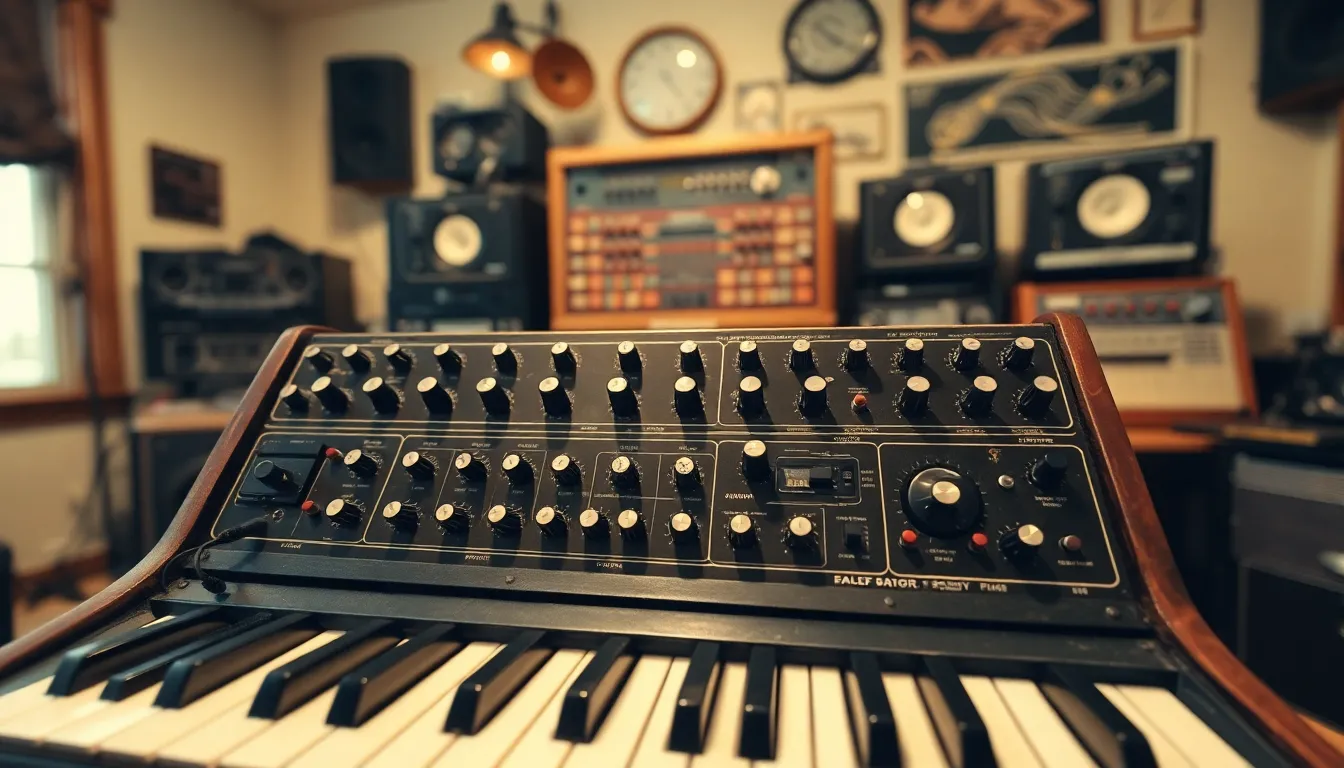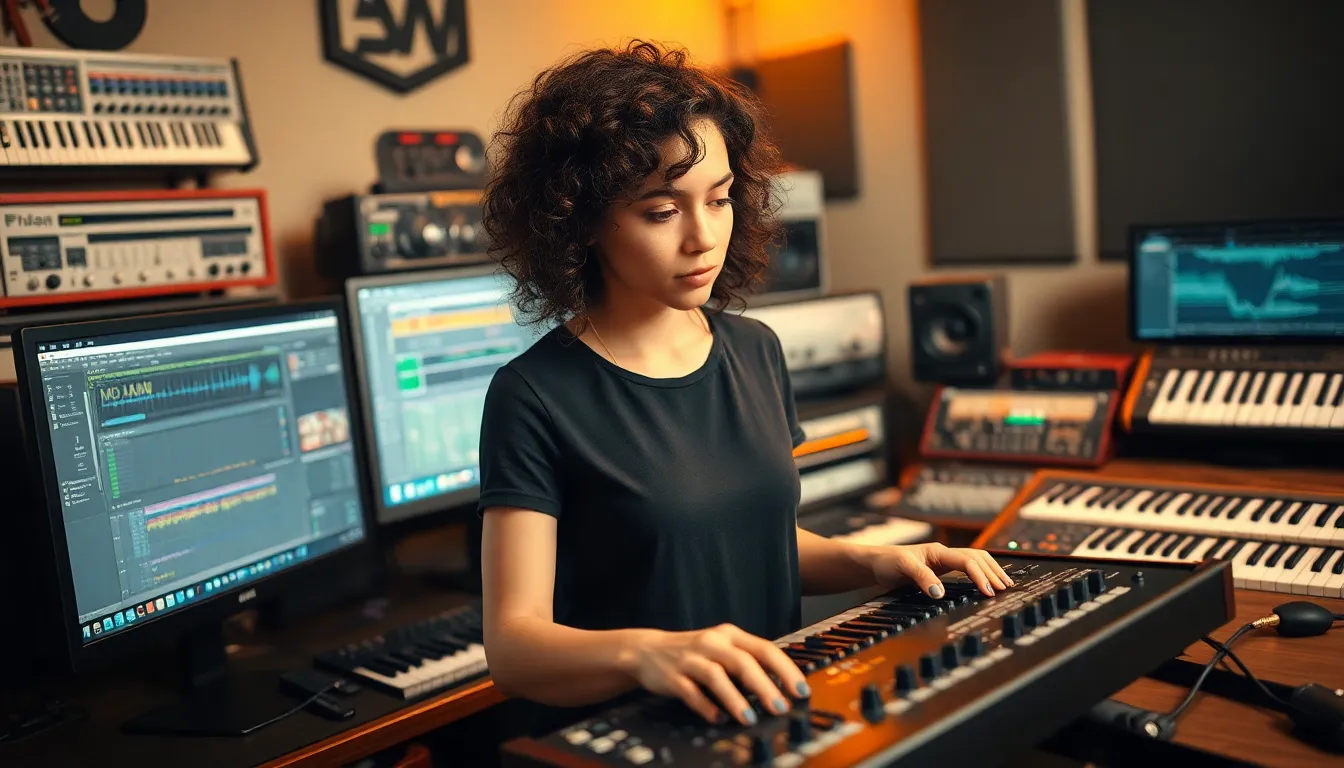Additive synthesis is like the Swiss Army knife of sound design—versatile, powerful, and a little bit magical. Instead of just layering sounds on top of each other like a toddler with building blocks, it breaks down complex tones into their fundamental frequencies. Imagine creating a symphony by simply tweaking a few knobs; it’s not just a dream, it’s additive synthesis in action.
Table of Contents
ToggleOverview of Additive Synthesis
Additive synthesis serves as a fundamental technique in sound design. This method breaks down complex tones into their core frequencies, enabling precise sound manipulation. Musicians and sound designers utilize additive synthesis to craft unique auditory experiences by adjusting specific parameters like amplitude and frequency.
Frequencies combine to create the desired sound wave, allowing for a wide spectrum of sonic possibilities. Various harmonic layers enhance richness, providing depth compared to traditional synthesis methods. This approach emphasizes the importance of understanding sound’s components for effective design.
In practical applications, additive synthesis finds use in software synthesizers and hardware units. Digital audio workstations offer tools for real-time manipulation, showcasing the versatility of this technique. Tools such as those found in programs like Serum or Max/MSP exemplify additive synthesis’s capability to produce sophisticated sounds.
Different parameters can be tweaked, yielding a myriad of variations from a single basic waveform. By altering harmonics, designers explore new textures and timbres, pushing creative boundaries. The adaptability of additive synthesis encourages experimentation across genres, making it a favorite among electronic music producers.
Each layer of sound contributes to the complexity of the resultant audio signal. Techniques also include manipulating envelope shapes, which alters how the sound evolves over time. This contributes to a dynamic and engaging listening experience, critical in modern sound production. Overall, additive synthesis remains a pivotal element in the exploration of sound design.
Historical Background

Additive synthesis has a rich history marked by key advancements in sound technology. This method reshaped the way music and sound are produced and understood.
Early Developments
Early exploration of additive synthesis traces back to the late 19th century. Notably, physicist Hermann von Helmholtz published “On the Sensations of Tone” in 1863, which laid groundwork for understanding harmonic spectra. Charles Ives, in the early 20th century, incorporated additive principles in compositions, highlighting its artistic potential. The first practical synthesis application occurred in the 1950s with the creation of the electronic music synthesizer, where multiple sine waves were combined to create complex sounds. By the 1960s, researchers like Max Mathews began developing computer-based synthesis techniques, enabling further experimentation with sound layers and acoustics.
Key Innovators
Several innovators significantly contributed to the field. Jean-Claude Risset pioneered computer music in the 1960s, utilizing additive synthesis to generate novel sounds by manipulating harmonic series. John Chowning expanded on these concepts, developing the Frequency Modulation synthesis technique, which drew from additive principles. Then, in the 1970s, David C. Johnson introduced the first digital additive synthesizer, known as the “Additive Synthesis Engine.” His work marked a monumental shift in the accessibility and complexity of sound design. These key figures set the stage for contemporary synthesizers, allowing musicians and sound designers to explore vast sonic territories.
Principles of Additive Synthesis
Additive synthesis focuses on creating complex sounds by combining individual sine waves. This method allows sound designers to explore a wide range of auditory effects.
Waveform Generation
Waveform generation serves as the cornerstone of additive synthesis. It involves creating basic waveforms, such as sine, square, triangle, and sawtooth waves. Each waveform exhibits unique characteristics, contributing to the overall sound. Designers manipulate these waveforms by adjusting parameters like frequency and amplitude. This flexibility leads to countless possibilities in sound design, inviting experimentation. By layering multiple waveforms, it becomes possible to create rich and textured sounds, enhancing the listening experience.
Harmonic Content
Harmonic content refers to the specific frequencies that comprise a sound. This content defines the timbre and quality of the resulting audio. With additive synthesis, it’s essential to understand harmonic relationships, as they dictate how the sound develops. By precisely controlling the amplitude of each frequency, designers can create nuanced sounds that range from simple to complex. The ability to add or remove harmonics allows for sophisticated tonal shaping. As a result, musicians can achieve a wide array of sounds tailored to various genres.
Applications of Additive Synthesis
Additive synthesis finds a wide range of applications in music production and sound design, enhancing creative possibilities for musicians and designers alike.
Music Production
In music production, additive synthesis enables the creation of intricate and dynamic soundscapes. Its ability to layer multiple harmonic frequencies results in rich textures that resonate with listeners. Musicians craft unique instruments by combining basic waveforms. They manipulate each layer’s amplitude and frequency, generating diverse sounds suited for various styles. Programs like Serum provide users with intuitive interfaces for real-time adjustments. Many producers appreciate its versatility for electronic genres, leveraging additive synthesis to push sonic boundaries, and produce engaging melodies. Further, understanding the harmonic relationships between frequencies allows for more intentional arrangements in compositions.
Sound Design
Sound design heavily benefits from additive synthesis due to its precision in sculpting sounds. Designers utilize this method to deconstruct intricate tones, gaining control over every frequency component. Creating complex soundscapes or effects becomes straightforward when manipulating individual sine waves. Many popular audio design tools integrate additive synthesis for custom sound production. Users often explore unique textures and timbres that traditional synthesis methods may overlook. Altering envelope shapes enriches how sounds evolve dynamically. As a result, additive synthesis remains essential for those seeking innovative and captivating audio experiences across various media formats.
Advantages and Disadvantages
Additive synthesis presents several clear advantages and disadvantages relevant for sound designers and musicians. Understanding these aspects helps users navigate its complexities.
Benefits
Additive synthesis offers a high degree of control. Designers manipulate individual frequencies, allowing for precise sound shaping. It provides the ability to create a wide variety of timbres, enhancing creativity in music production. Harmonic layering enriches the sound, creating depth that resonates well with listeners. Designers can craft unique instrument sounds that traditional synthesis methods struggle to achieve. Real-time adjustments in software like Serum contribute to its popularity, while its versatile applications span genres and media. This method also fosters experimentation, encouraging users to explore new sonic territories.
Limitations
Additive synthesis comes with certain limitations. Complexity may arise when managing numerous frequency components, leading to potential confusion. It often requires extensive knowledge of sound theory to navigate effectively. Processing power is a consideration; complex additive patches can demand significant resources from digital audio workstations. Time investment is necessary for effective sound design, as crafting intricate sounds often involves meticulous tweaking. Not all synthesizers support additive synthesis, which can limit accessibility for some users. These factors highlight the need for balanced approaches in utilizing additive techniques.
Additive synthesis stands out as a transformative approach in sound design. Its ability to dissect complex tones and manipulate fundamental frequencies empowers musicians and sound designers to explore new sonic territories. This technique not only enhances creativity but also encourages a deeper understanding of sound’s intricate components.
Despite its challenges, such as the need for technical knowledge and processing power, the rewards of additive synthesis are immense. It offers unparalleled control over sound shaping, resulting in rich and dynamic auditory experiences. As technology continues to evolve, additive synthesis will undoubtedly remain a cornerstone of innovative sound design, inspiring future generations to push the boundaries of music and audio creativity.

